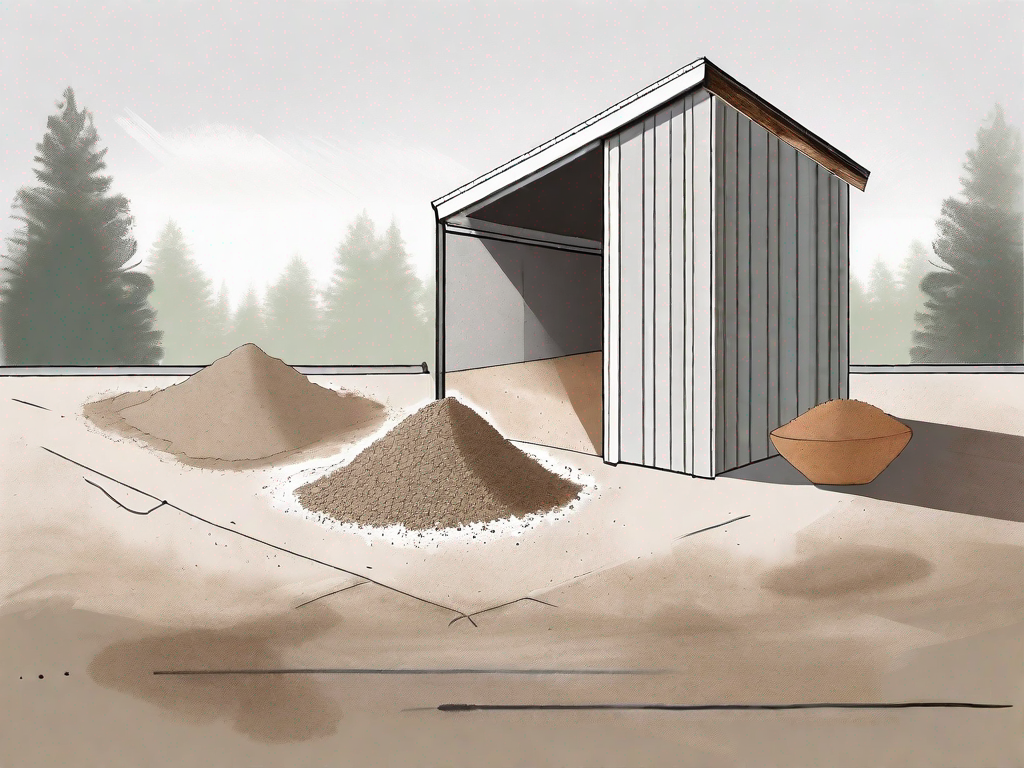Can Polymeric Sand Be Used For A Shed Foundation Project?
Published on: May 13, 2024
Get an estimate for your project in 60 seconds

When it comes to shed foundation projects, the choice of materials can significantly impact the durability and longevity of the structure. One material that has gained popularity in recent years is polymeric sand. But is it suitable for a shed foundation project? Let’s delve into the details.
Understanding Polymeric Sand
Polymeric sand is a unique mixture of fine sands combined with other additives (polymers), that, when mixed with water, form a surprisingly strong binding agent that can be used in various hardscaping projects. Over the past decade, it has gained popularity due to its durability and versatility.
Unlike regular sand, polymeric sand reduces the erosion process, keeps the pavers in place, and prevents weed growth and insect infestations. It’s these qualities that make it a potential candidate for shed foundation projects.
Benefits of Polymeric Sand
One of the main advantages of polymeric sand is its durability. The binding agents in the sand create a strong, flexible joint that withstands weather conditions and the test of time. This makes it an excellent choice for outdoor projects, including shed foundations.
Another benefit is its resistance to weed growth and insect infestations. The tight bond it forms prevents weeds from growing and insects from burrowing, ensuring the integrity of your shed foundation.
Using Polymeric Sand for Shed Foundation Projects
While polymeric sand is not a traditional choice for shed foundations, it can be a viable option in certain circumstances. The key is understanding when and how to use it effectively.
For smaller, lighter sheds, polymeric sand can provide a stable, durable foundation. It’s also a great choice if you’re building your shed on a slope, as the sand can be easily shaped to match the terrain.
How to Use Polymeric Sand for Your Shed Foundation
Using polymeric sand for your shed foundation involves a few key steps. First, you’ll need to prepare the site by removing any grass or vegetation and leveling the ground. Next, you’ll lay a base layer of crushed stone or gravel for added stability.
Once the base layer is in place, you can add the polymeric sand. It’s crucial to follow the manufacturer’s instructions for mixing and applying the sand to ensure a strong bond. After the sand is in place, you’ll need to compact it and add a final layer of sand on top.
Finally, you’ll place your shed on top of the foundation and secure it in place. It’s recommended to check the stability of the shed and make any necessary adjustments to ensure it’s level.
Where to Buy Polymeric Sand
Polymeric sand is widely available at home improvement stores, but for larger projects, you may want to consider a bulk supplier. One such supplier is Hello Gravel, a company known for their high-quality materials and excellent customer service.
They offer a variety of polymeric sand options, allowing you to choose the one that best fits your project needs. Plus, their team of experts can provide advice and guidance to ensure your shed foundation project is a success.
Alternatives to Polymeric Sand for Shed Foundations
While polymeric sand can be an excellent choice for certain shed foundation projects, it’s not always the best option. Depending on the size and weight of your shed, other materials may be more suitable.
Concrete, for example, is a traditional choice for shed foundations. It’s incredibly strong and durable, making it ideal for larger, heavier sheds. However, it can be more difficult to work with and may require professional installation.
Gravel is another popular choice. It’s easy to work with, provides excellent drainage, and can be a cost-effective option. However, it may not provide the same level of stability as polymeric sand or concrete.
Getting a Quote for Your Shed Foundation Project
If you’re considering using polymeric sand for your shed foundation, it’s a good idea to get a quote from a reputable supplier. Hello Gravel offers a simple, straightforward quote form on their website, making it easy to get an estimate for your project.
Remember, the cost of your project will depend on several factors, including the size of your shed, the type of polymeric sand you choose, and any additional materials or labor required.
Conclusion
In conclusion, polymeric sand can be a viable option for shed foundation projects, particularly for smaller, lighter sheds or those built on sloping terrain. Its durability, resistance to weeds and pests, and ease of use make it an attractive choice.
However, it’s important to consider all your options and consult with a professional if you’re unsure. Whether you choose polymeric sand, concrete, or gravel for your shed foundation, the key is to ensure a stable, durable base that will support your shed for years to come.
Ready to Build a Solid Foundation?
Choosing the right foundation is crucial for the longevity of your shed. At Hello Gravel, we understand the importance of quality materials. Whether you’re considering polymeric sand or need other high-grade aggregates for your project, we’ve got you covered. Experience our white-glove service and let us handle the heavy lifting. Simply check out our products, request a quote, or place your order online, and we’ll deliver directly to your site, no matter the size of your project. Build with confidence and let Hello Gravel be the foundation of your success.
Author: Erik Schultz